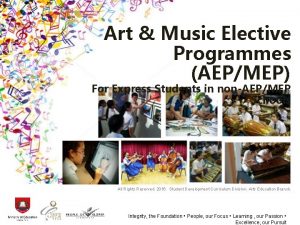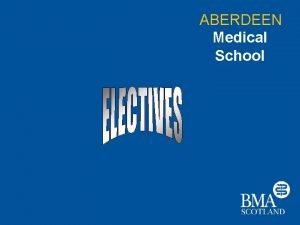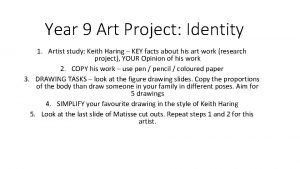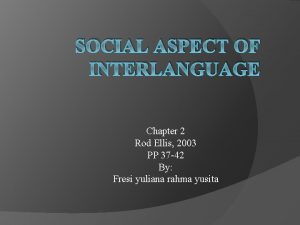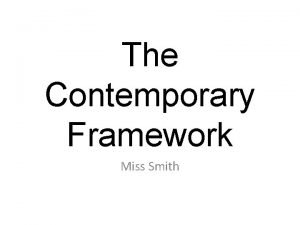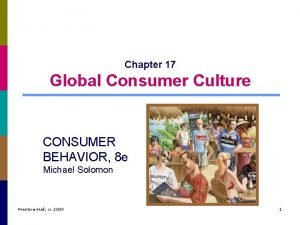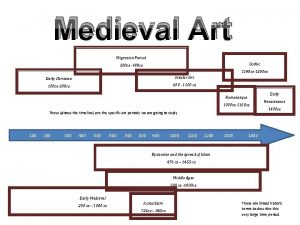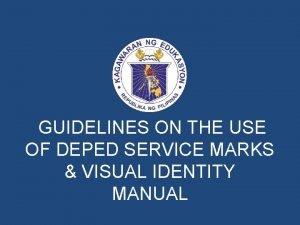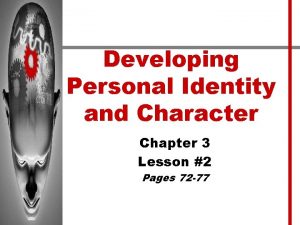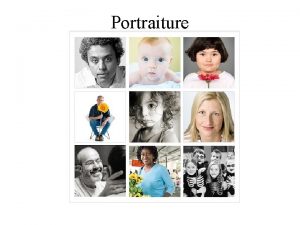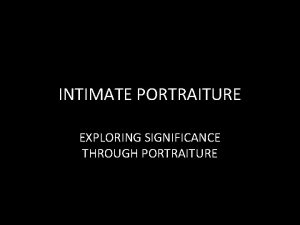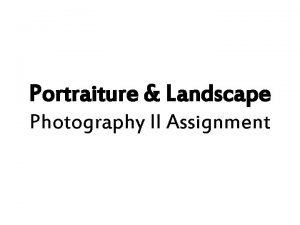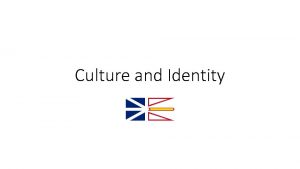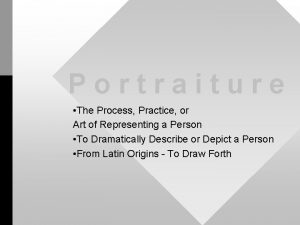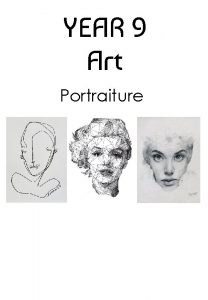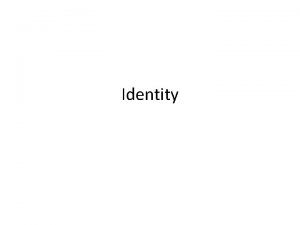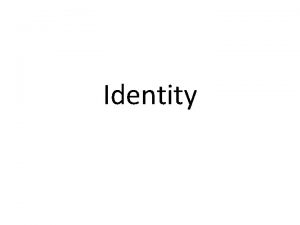PORTRAITURE ART AND IDENTITY Mr Sheaffer Art Elective






















- Slides: 22

PORTRAITURE, ART, AND IDENTITY Mr. Sheaffer Art Elective Chuck Close in his studio before “The Event”

Leonardo Da Vinci The Mona Lisa (La Gioconda) 1502 The Mona Lisa has been acclaimed as “the best known, the most visited, the most written about, the most sung about and the most parodied work of art in the world”. Its fame rests, in particular, on the elusive smile on the woman’s face.

Rembrandt van Rijn Self-Portrait 1657 From the beginning of his career in the 1620 s to the year of his death in 1669, Rembrandt painted more than 90 portraits of himself. He used “Chiaroscuro” techniques (light and dark) to emphasize the facial features to create a dramatic effect.

Jan Vermeer The Girl with the Pearl Earring 1665 Nothing in known about the model appearing in this painting. Still, Girl with a Pearl Earring is one of the most famous portraits ever created. Perhaps the mystery surrounding the painting adds to its fame. In 1999, novelist Tracy Chevalier wrote a historical novel with the same title as the portrait, a fictional story of the creation of Vermeer’s masterpiece. It was later made into a film with the same title which was nominated for three Academy Awards.

Gustave Courbet Self Portrait as a Desperate Man 1845 Courbet was not depicting beauty, he was depicting truth. When you look at this self-portrait you not only experience his desperation, but you also get the idea of what kind of personality Gustave Courbet was himself. Bold, wily, radical, ambitious and determined.

Mary Cassatt Self-Portrait 1880 Mary Cassatt created this watercolor, one of her few self-portraits, around 1880. Cassatt used her art to address the many roles of the modern woman: as mother, as intellectual, and here, as professional artist. Cassatt returns the viewer's gaze, , suggesting that the artist is watching the viewer.

Vincent van Gogh Self-Portrait With Bandaged Ear 1889 The following quote appeared in the Arles journal Le Forum Republicain on December 30, 1888: Last Sunday, at 11: 30 in the evening, Vincent Van Gogh, a painter of Dutch origin asked for a woman called Rachel and handed her … his ear, saying: 'Guard this object with your life'. Then he disappeared. When informed of the action, which could only be that of a pitiful madman, the police went the next day to his house and discovered him lying on his bed apparently at the point of death. The unfortunate man has been rushed to hospital.

Pablo Picasso Self-Portraits, 1896 -1971 Age 15 Age 18 Age 20

Age 25 Age 56 Age 90

Salvador Dali Soft Self Portrait with Grilled Bacon 1941 Dali has here caricatured his public image in a spirit of self-mockery. He uses the upturned moustache to make it recognizable. He uses crutches to show we decay as we age. The ants coming out of his eye also represent death and decay. Dali was fascinated with Sigmund Freud’s ideas regarding the meaning of our dreams.

Norman Rockwell Triple Self-Portrait 1959 The four self-portraits pictured on Norman Rockwell’s canvas in Triple Self. Portrait (1959) – Albrecht Dürer, Rembrandt van Rijn, Pablo Picasso, and Vincent Van Gogh – are his inspiration. He invites us to compare how other artists tackled the problem of a selfportrait. This was painted as a cover illustration for the “Saturday Evening Post”.

Frieda Kahlo Self Portrait, 1945 Frieda shows the animals and the Aztec sculpture to connect herself to nature and her indigenous past. The ribbon ties these elements together and also represents life lines. "I wish to be worthy, with my paintings, of the people to whom I belong and to the ideas which strengthen me. "

Andy Warhol Marilyn Monroe 1962 The photograph Warhol selected was a publicity shot from the 1953 movie 'Niagara' which Marilyn had previously starred in. Marilyn embodies celebrity status and fame. Featuring famous people in pop art became one of the defining characteristic of the movement throughout the 60 s: it is an ironic commentary about our modern obsession with celebrity culture. He suggests that we often see celebrities as a product rather than a person.

Cindy Sherman 1980’s to present Sherman uses photography to explore common female social roles or “personas”. She questions the influence of mass media on individual and group identity. Sherman uses the camera and tools such as makeup, costumes, and stage scenery, to recreate common illusions, or iconic "snapshots”. In a sense, she is carrying on an idea started by Mary Cassatt in the 1890’s.

Hyun Mi Yu Self Portrait 2010 Hyun Mi Yoo combines painting and photography here to create a vivid mixedmedia self-portrait. "We often admire an eloquently depicted painting, saying that it is like a photograph. We also might say a very beautiful photograph looks like a painting. " Hyun Mi Yoo captures this blurring of boundaries: between painting and photography; between two- and threedimensional planes; between artist and model.

David Hockney 82 Portraits and One Still-life 2014 His subjects – all friends, family and acquaintances – include office staff and fellow artists. Each work is the same size, showing his sitter in the same chair, against the same vivid blue background all were painted in the same time frame of three days. Yet Hockney’s paintings allow their different personalities to leap off the canvas with warmth and personality. Margaret Hockney John Baldesarri


George W. Bush Portraits of Courage Robert Ferrara 2017 Robert Ferrara sustained a shoulder injury when a roadside bomb detonated near him in Iraq in 2007. Robert recognizes that his recovery will be lifelong. Robert says the painting captures the pain he is living with, though he is happy again and full of love. He lives in Texas where he helps other wounded warriors heal through sports and mountain biking.

Chuck Close Big Self-Portrait 1968 Closes's untraditional approach involves creating a unique kind of "mug shot, " a up close style that emphasized the subject's blemishes and the original photographic distortion caused by the camera. Close refused all commissions and used only his own "mug" and that of close friends for his subjects.

Chuck Close Self Portrait 2007 On December 7, 1988, Close felt a strange pain in his chest. That day he was at a ceremony honoring local artists in New York City and was waiting to be called to the podium to present an award. Close delivered his speech and then made his way across the street to the hospital where he suffered a seizure which left him paralyzed from the neck down. Close has called this “The Event”. Since then he uses materials and techniques that do not lend themselves well to achieving a photorealistic effect. He uses small bits of irregular paper or inked fingerprints to achieve astoundingly realistic and interesting results.


How do you see yourself?
 Streamü
Streamü Academic writing and composition
Academic writing and composition Aberdeen electives
Aberdeen electives Introduction ng sanaysay
Introduction ng sanaysay College preparatory elective examples
College preparatory elective examples Elective ict
Elective ict Intoxication énolique
Intoxication énolique Personal identity identity map
Personal identity identity map Identity art project
Identity art project Stylistic continuum
Stylistic continuum Interlanguage and stylistic continuum
Interlanguage and stylistic continuum What is contemporary framework
What is contemporary framework Global consumer culture positioning example
Global consumer culture positioning example Migration period art
Migration period art Iam capability model
Iam capability model Property names math
Property names math Texts about identity and belonging
Texts about identity and belonging Deped service marks and visual identity manual ppt
Deped service marks and visual identity manual ppt Gender roles and identity
Gender roles and identity What is good character
What is good character Lesson 2 developing personal identity and character
Lesson 2 developing personal identity and character Your conscious awareness of your own name
Your conscious awareness of your own name Merritt maxim forrester
Merritt maxim forrester
